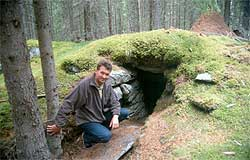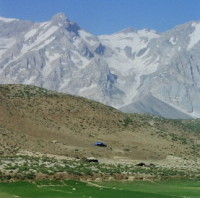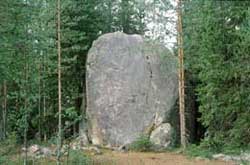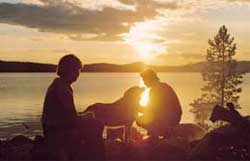
Photo. A local person, Kjell
Magne Nordvi shows where the ghost from a hanged man
lives! Copyright: Finnskogen Villmarkssenter og
Per
Henriksen (www.Reiseliv.no).
Here
you can hear stories you
wouldn't believe before you heard them from the local person Kjell Magne Nordvi. Furthermore you
can experience ghosts, sun crosses on the ground where nothing grow and many
unexplained incidents, he says. And in the evening you can hear the wolf howl.
The Finnskogen (forest) is wonderful for trekking, fishing
and nature adventures. There are several trekking routes trough the large wood
and along small lakes.
This article is
based on Per Henriksen`s article on
the Norwegian travel guide (portal) Reiseliv - www.Reiseliv.no.
The Finnish
comes
In the 1600's
Finnish (Finns) fled from poverty and crop failure in their homeland and moved
to a huge and inhabited the forest area between
Sweden and
Norway. The
border was not exactly lined up at that
time. On the Norwegian side of the border the Finnish settle down. Traces are
shown today by the Finnish names Särgelamp, Lebiko and Balagombo deep in the
Norwegian forest Finnskogen.
The immigrations
brought with them many myths and customs that still exist today, together with
several culture objects. The Finns built their huts with central fireplace and a
hole in the roof, bathed in their saunas and cultivated the land in traditional
ways. "Svedjebruk" is the name for sowing rye in the ash from burnt spruce.
Connection with
Iran and other far away
countries?
Here you find
remains of the Urgis language which was first brought to
Finland and
so to Norway
. There are also wild rye fields with origin from
Iran
(Persia) here. How can it be explained?
|
Photo. Mountains in
Iran.
Where did the Finnish people the special knowledge about seeding and
growing?
Maybe the
Finnish people descended from the mountains in
Iran
(Persia), with relations to
Egypt?
Was the wild rye imported from Iran? |
 |
The Finnish (Soumi) word
for delta is "niloe". Could this word originally be derived from
Egypt, more
exact from the delta river Nile?
Mysteries
One of the most
mysteries things here is this huge stone (rock) which rests on a circle of small
stones. It's so big and heavy that it's unlike that humans have managed to lift
or moved it. How has the stone been placed here? Has it been used witch
craft?
|
Photo. A mysterious huge stone
in the middle of a stone circle in Finnskogen (forest) in
Norway.
Copyright:
Finnskogen Villmarkssenter og Per
Henriksen (www.Reiseliv.no). |
 |
There are many
things to wonder about here. One of the persons who wonder about all these is
Kjell Magne Nordvi. He knows the Finnskogen (forest)
quite well and he is the owner of the Finnskogen Villmarkssenter (wild life
centre). By reading several books he is full of knowledge about this story
and the life on Finnskogen. And through the year he tells many exciting stories
that make people's hair rise on their heads.
Kjell Magne
Nordvi kno ws about a small cellar with stored food where it's still ghosts (see the photo
on the top of the page). The cellar is well hidden in the forest, and was
a part of the dwelling to a small Finnish farm called Bekka, which vanished
for along time ago. With exception of the cellar. Inside here
have several visitors experienced frightening things, when they finally have managed to
crawl through the small entrance, and in to the nearly 2m3 small room. It's said that
the ghost from a hanged man still lives here.
There are more
frightening stories about the life on Bekka, which became built in 1651.
Opportunities
today
The descendants
of the old Finnish (Finns) are modern Norwegians, but they are proud of their
roots. Finnskogen has its own museum, its annual Finnskog exhibition and many
restored farms. Every summer the Republic of
Finnskogen is
announced, an event lasting one week with many Finnish visitors.
The "Finnskogleden" stretches through
Finnskogen a well marked footpath. You can walk for one
day or several days and enjoy both nature and culture. There is an exciting animal life
here too, and i n the evenings you can hear the
wolf howl.
|
Photo. Sunset in Finnskogen (forest) in
Norway.
It could be really beautiful in the evenings here. The wilderness
really turns you on! |
 |
So, where did the Finnish
people get this knowledge? And where do the
Finnish people come from. The wild rye, sereale segale, can be found in
Afghanistan and Aserbajdjan. It`s
resemblance between the Finnish language and Sanskrit. Some of the
knowledge about this special
kind of farming is also known in
Egypt. Maybe the Finnish people
descended from the mountains in Persia, with relations to
Egypt? Anyway the traditions here are
so old and strong that some of them don't exist in
Finland anymore!
Read more about the mysterious Finnskogen in our coming
article part 2: sun crosses, ghosts, strange rituals and many other strange
things that still exist in this forest. Does the wood nymph really exist here?
Stein Morten
Lund, 26 September
2004
Additional
information
This article is
based on Per
Henriksen`s article on the Norwegian
travel guide (portal) Reiseliv - www.Reiseliv.no.
Copyright for photos: Finnskogen Villmarkssenter og
Per
Henriksen
(www.Reiseliv.no).
For more
information:
Finnskogen Turist & Villmarkssenter
(Finnskogen tourist and wildlife centre) is happy to give you more
information about the Finnish immigrants and their culture (Finnskogen Turist
& Villmarksenter AS, Skasenden 2260 Kirkenær) - click on the link here: Finnskogen
Villmarkssenter.
Read about
routes, maps etc. at Finnskogen Tourist Centre website: Finnskogen Turistforening.
Activities:
Wandering:
Finnskogen has
lots of marked trails, and the most famous are Finnskogleden, which reaches from
Magnor till Trysil, another one is Finnevegen
which passes trough the Center. They can offer you maps, and they can also drive
you back and forth to these trails.
Other activities
are canoe and kayak, paint ball, tennis course, rally cross, hunting and
fishing, driving with a dog team and Smoke sauna
Smoke
sauna:
The sauna in
Finnskogen is suitable after a day in the nature. The sauna is warm for several
hours. The smoke is being let out through a hole in the back wall. 5 minutes
before use, we take the coal out and we ventilate the sauna. You can
now take a bath for several hours, and in between you can take a bath
in the lake, both summer and wintertime. The sauna can room 20 people, but
please notify us one day before, so we have the time to warm it
up.
*******************************************************************************
Information and relevant links in Norwegian follows:
Fakta:
Finnskogen er et variert
skoglandskap med en helt spesiell historie. Til
dette grenseområdet mellom Norge og Sverige kom finner fra Savolax og Tavastland
på 1500- og 1600-tallet på leting etter nye leveområder. De fant et vidstrakt
morenelandskap med mye skog, lite folk, rikt dyre- og fugleliv og gode
fiskevann. Det samme kan vi finne i dag, men i tillegg har finnenes bosetting
satt varige spor etter seg. Denne historiske bakgrunnen gjør
Finnskogen til et ekstra spennende område for oppdagelses- ferder i natur og
kultur.
Finnskogleden følger gamle stier og ferdselsveger
gjennom
skogene, langs vannene, over toppene og forbi finnetorpene fra Eda i sør til
Trysil i nord. Her får du muligheten til å oppleve Finnskogens
særegne kulturtradisjoner i sitt rette miljø. En vandring langs Finnskogleden
gir deg nærkontakt med naturen - og deg sjøl. (Kilde Glåmdal
Reiseliv
).
Noen gode råd:
Terrenget er familievennlig, men det er langt mellom butikker, telefoner og
fastboende. Standarden er enkel, og du går på eget ansvar.
Du behøver ikke spesialutstyr av noe
slag for å vandre på Finnskogleden - fornuftige klær, regntøy og joggesko eller
gummistøvler rekker langt.
Vannet i bekker og kaldkilder kan
drikkes.
Beste vandringssesongen er fra 1. juni til 1. oktober. Er det lite snø, kan også
mai og november være fine måneder. Oktober er
elgjakttid.
Flere hundre grunneiere har vist oss vandrere sin
tillit ved å si JA til Finnskogleden - la oss vise dem at vi er tilliten verdig!
(Hentet fra Glåmdal
Reiseliv
).
Linker:
Les flere historier hos Finnskogen
Villmarkssenter
Les om stier, kart m.v. på Finnskogen Turistforening
Les om turopplevelsene hos Glåmdal
Reiseliv
Les om Stiftelsen
Finnskogen (svensk)
Museum i Torsby
i Sverige: Torsby
Finnkulturcentrum
